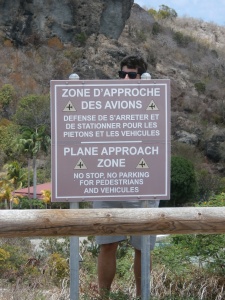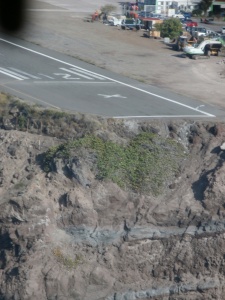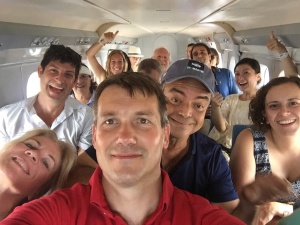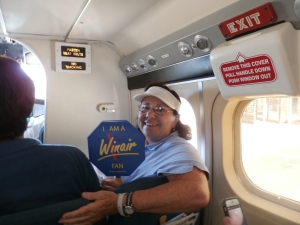By Kathryn B. Creedy
An AvGeek’s a trip to St. Maarten is not complete without the experience of flying to St. Barth and Saba but don’t get in the way of the landing aircraft or, at least at St. Barth, the gendarmerie will be on you in a flash. More on that later.
St. Maarten is most assuredly one of the greatest #AvGeek spots on earth as illustrated by my recent report for Beachcombers Chronicles. St. Maarten is, indeed, a unique beach adventure and that is what Beachcombers Chronicles is all about. The aircraft thundering into Princess Juliana International Airport (SXM) come within a hair’s breadth of sunbathers on Maho Beach. Few places in the world offer a spectacle of aircraft in flight so close it seems as if you could reach up and touch their dangling landing gear. And SXM has Sunset Beach Bar where aviation geeks and non-geeks alike gather to watch the miracle of flight on this 37-mile stretch of paradise.

Most shots of aircraft landing at SXM are taken over Maho Bay. This is KLM 747 taking off from SXM. Courtesy of Alain Duzant.
But it is the operations at St. Barth and Saba that really set an AvGeek’s heart aflutter. St. Barth was featured in the History Channel’s Most Extreme Airports, which named it the third most dangerous airport in the world. St. Maarten, known as the gateway to the Caribbean, came in fourth in the program which cited the sharp incline on takeoff and right turn necessary to avoid the 2,400-foot (800-meter) mountains to the east of the runway. Oh, and of course, it cited the crazy fence surfers who hang on to the fence surrounding the airport as thousands of pounds of thrust from departing jet aircraft literally blow them away.
Saba didn’t make the History Channel’s list but has made other challenging airport lists and rightly so. Saba has been correctly described as trying to land on an aircraft carrier because it has 60-foot drops at either end of the runway with Cove Bay on one end and the sparkling waters of the Caribbean on the other. However, it has a healthy 1,300-foot length, four times that of an aircraft carrier and it doesn’t pitch and roll as aircraft carriers do.
It is little wonder the two airports take special training and the controllers at St. Barth have a photo album of those who went nose over in the sand or ended up in the clear blue waters of the Baie de St. Jean. Local aviators know that the incidents result from pilots not heeding the warnings about how challenging the airport is. One jet even attempted the landing and didn’t make it. Now, that was a cocky pilot who didn’t know or care that St. Barth is strictly a piston and turboprop airport. Despite the challenges and accidents, there have been no fatalities, a testament to the care and skill of the pilots that regularly serve the island.
For unsuspecting passengers and veteran aviators alike, the St. Barth’s approach is a thrill. We jostled our way on board hoping to sit in the front of the Winair Twin Otter for a bird’s eye view of the flight and landing through the cockpit window. Little did we know that at both Saba and St. Barth, the best place to sit is in the back for a far more dramatic feeling of the steep angle on approach. But we were as excited as kids on Christmas morning and wanted to get the best shots. Oh, well, always leave something for next time.

Our group was about a dozen aviation and travel reporters each wanting the best view for the approach at St. Barth. Courtesy Alain Duzant.
Wandering Aramean Blogger Seth Miller, mounted his GoPro just behind the first officer while PrivateFly’s Adam Twidell kept his smartphone camera rolling throughout the flight. The rest of us were crowded behind them in the unpressurized, un-air conditioned aircraft doing heaven knows what to the center of gravity. We knew we were in for something special because SXM Air Traffic Control Supervisor Duncan van Heyningen described the approach during briefings chuckling as he explained how difficult it was.

SXM Air Traffic Control Supervisor Duncan van Heyningen briefed us that we were in for a great ride in describing the approach at St. Barths. Photo by Kathryn B. Creedy.
None of us, however, expected a 10-degree, nose-down attitude as we approached. The left wing seemed to barely skim the mountain before we dropped on to the runway. For Captain Carlyle Dubline and First Officer Alexander Spencer, however, it was just another day at the office.

The Winair Twin Otter skims over the heads of assembled AvGeeks trying to get the best shot of this absurd approach. Courtesy Alain Duzant.

Aircraft have to dodge traffic on the traffic circle atop the gap between the two mountains through which pilots have to thread their way. Traffic included huge boats and construction cranes sticking well into the sky. Courtesy Alain Duzant.

Aircraft have to navigate their way down a steep slope as they land at St. Barths. The aircraft on final is Winair’s Twin Otter while the Tradewind aircraft in the foreground is a Pilatus PC 12. Photo by Kathryn B. Creedy.
Local aviators know that it takes good hand-eye coordination as well as very good stick and rudder skills. Operations can only be done in VFR conditions. The aircraft used at these airfields may not have the sophisticated automation of larger and newer aircraft but these are airports where you wouldn’t want automation anyway.
“Pilots need a separate certification for Saba and St. Barth’s,” Winair Chief Pilot Jeff Oliver told Winging It. “Certification calls for six landings to be qualified at St. Barth’s and a minimum of three at Saba. But our training exceeds those minimums.”

Winair Chief Pilot Jeff Oliver explains the tricky landings at St. Barth and Saba and what it takes for a pilot to get certified to land at these two difficult destinations. Photo by Helena de Bekker.
The transition from first officer to captain at Winair typically takes between three and three and a half years, according to Oliver. However, once they transition to the left seat, they need a minimum of 100 hours as pilot in command before they can begin training for landings at Saba and St. Barth. Considering Winair flights are between 12 and 35 minutes that is a lot of flying time for these pilots but with a pilot corps between 32 and 36 and 18,000 flights annually we could say that time flies.
St. Barth Gustaf III Airport (SBH) runway is 2,133 feet (650 meters). Commercial services includes Winair’s Twin Otters, St. Barth Commuter’s Cessna Caravans and Britten Norman Islanders as well as Tradewind’s Pilatus PC 12.
While it is a short runway, it is the approach that is the challenge. Aircraft are required to thread the needle through a gap in a mountain. On top of that gap is an extraordinarily busy traffic circle and approaching aircraft come excruciatingly close to the traffic below before abruptly dropping down a slope to the airfield.

Winair Twin Otter prepares for landing with a dramatic nose dive into the airport. Courtesy of Chris Kjelgaard.
In fact, while the terrestrial traffic dodged our excited party standing atop that gap, one of the St. Barth Commuter pilots called in an alarm to the control tower about some silly group that was interfering with air traffic and ignoring the warning signs restricting the areas on which we could stand. A few minutes later, the gendarmerie arrived scolding us, moving us away from the flight path. Meanwhile, the pilot had gone around and only after we were cleared did he attempt the landing coming in just feet over our heads.

It is not as if we weren’t warned that we were violating the approach air space as we scrambled around the hill and traffic circle positioning to get the best shot. We were soon dispersed by the gendarmerie. That’s Wandering Aramean Seth Miller in the photo. Photo by Kathryn B. Creedy.
The runway at Juancho E. Yrausquin Airport (SAB) on Saba is the shortest commercial runway in the world at 1,312 feet (396 meters) and only 65 feet wide. It is flanked by a mountain on one side and sea on the other. Operations are restricted to the Twin Otter or the Britten Norman Islanders.

Saba has 60-foot drops at either end of the 1300-foot runway and it takes a lot of special training to navigate the windy, mountain-bound approach. Photo by Kathryn B. Creedy.
“Saba used to be more challenging,” said Winair Chief Pilot Jeff Oliver, “before the airport blasted away at some of the mountain. There is still very little room for error, particularly if the pilot has to go-around, but that’s a major part of the training. It is still challenging at times since you may get sudden wind direction changes. When the winds are from the north, runway 30 for departure is only permitted when the wind direction is within 30 degrees of the runway direction, with a minimum wind speed of 15 knots. However, these conditions pose another problem because they tend to push you further towards the mountain particularly on a go-around. It also has an uphill slope of three degrees, which helps with landing. Clearing away part of that hill makes it more relaxing.”
Well, relaxing after a fashion. When approaching runway 12, the approach requires a flight straight at the mountain before the pilot makes a sharp left turn to line up for approach and landing.
St. Maarten can rightly be described as an aviation geek’s paradise but if you want more than the world’s best plane spotting venue, you must experience St. Barth and Saba. As for Saba, we had no time for anything except a quick turnaround, which astonished the customs and immigration official that approved our entry into and exit from the island in one swift maneuver. With the too-short visits to these wonderful islands, I look forward to exploring them at length in the future.
Oliver summed up the experience with a chuckle. “People all over the world decide to make the Caribbean a destination,” he said, adding “They are guaranteed to like it because of where we fly. But it’s the landings that are worth the price of the ticket alone.”







